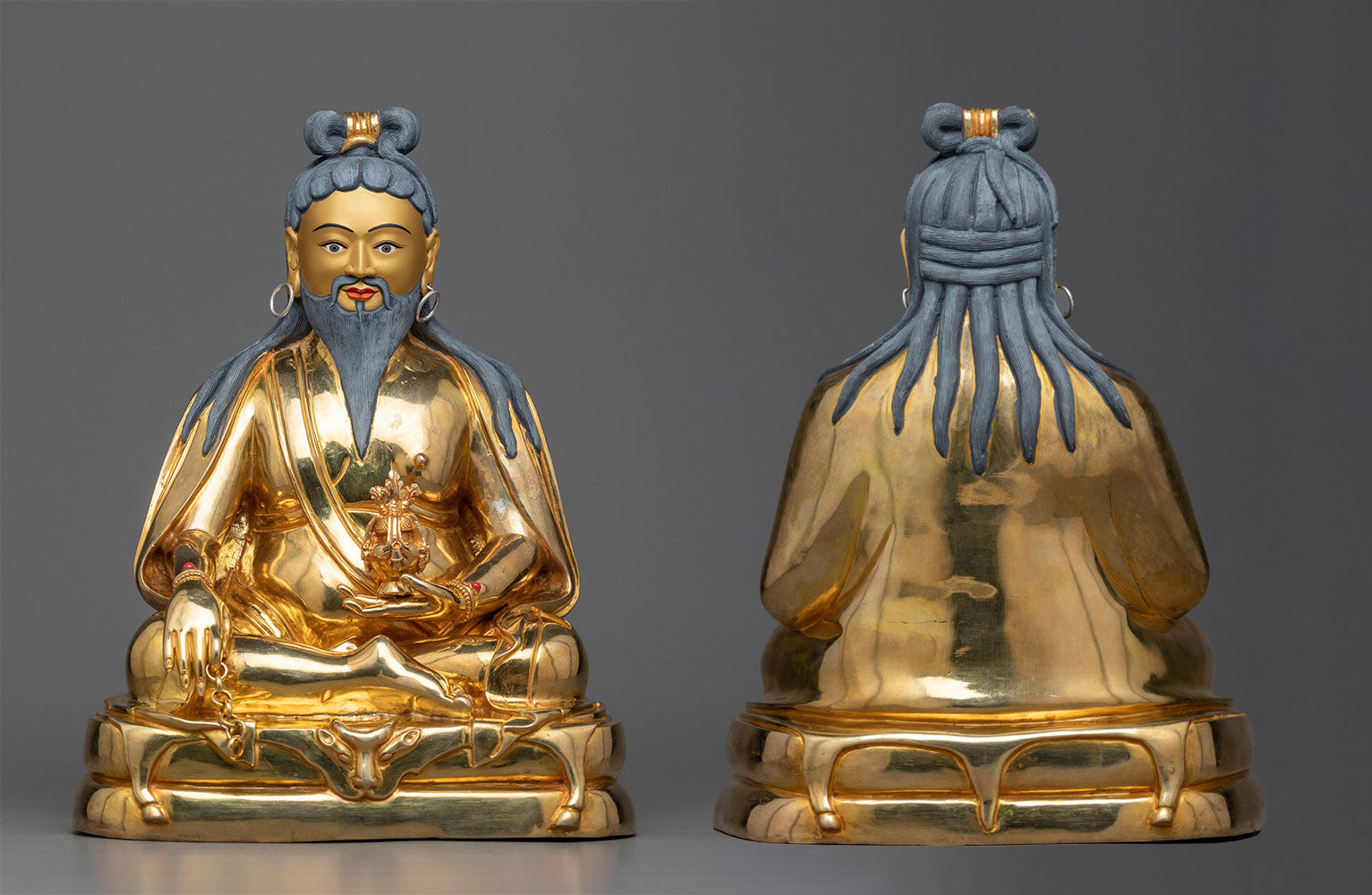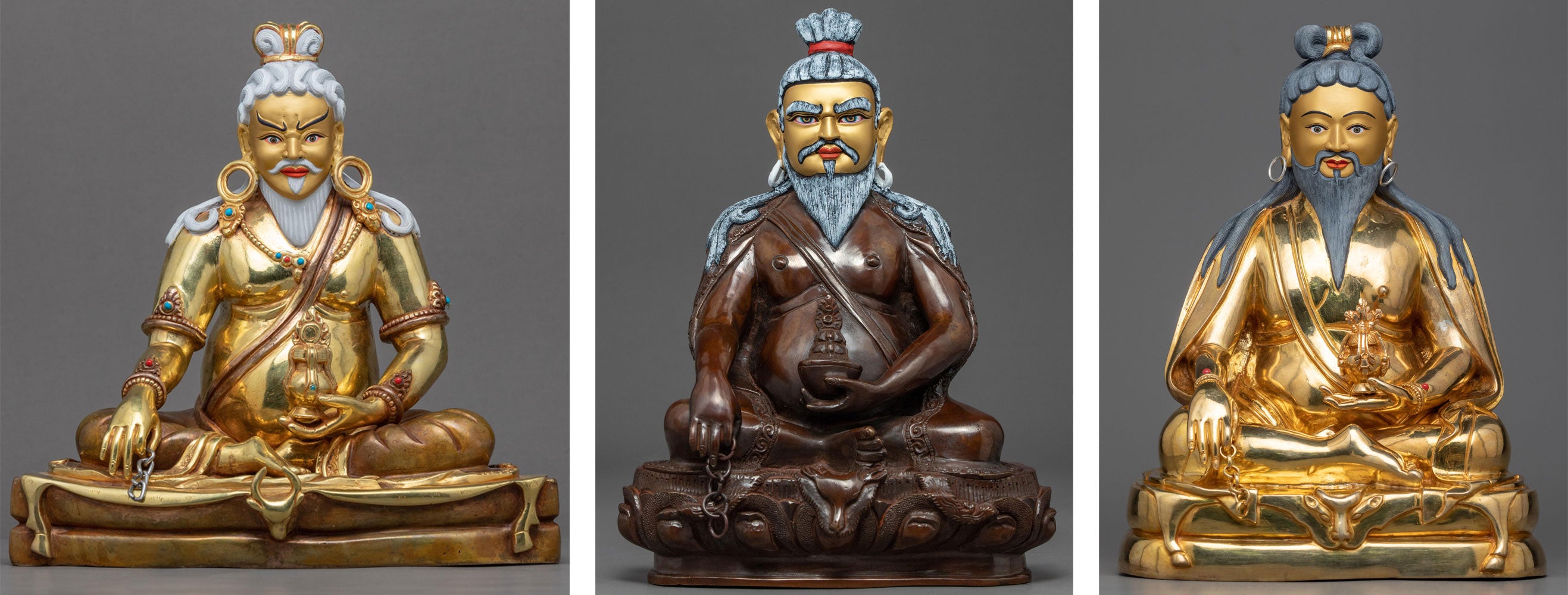Thangtong Gyalpo: Architect, Saint, and Visionary of Tibet
Thangtong Gyalpo ("The King Of The Empty Land"), widely esteemed as a polymath in Tibetan Buddhism, represents a captivating blend of spirituality, engineering, and artistry. His life and achievements, spanning the late 14th to early 15th centuries, provide an intriguing perspective on the relationship between religious commitment and practical ingenuity.
Thangtong Gyalpo, also called Chakzampa or the Iron Bridge Builder and Tsondru Zangpo, meaning "Excellent Persistence" , is honored not just for his advancements in engineering and the arts but also for his spiritual achievements.
Thang Tong Gyalpo, often referred to as the "iron man of Bhutan" and the "Leonardo da Vinci of the Himalayas," was a versatile figure renowned as the king of empty fields.
He was an artisan, engineer, composer, poet, soldier, merchant, and more. His repertoire was matched only by his extraordinary achievements.
Key Takeaways
- Thangtong Gyalpo was a pioneering figure in Tibetan Buddhism, known for his roles as a spiritual leader, engineer, and artist.
- He is credited with the invention of iron chain bridges in Tibet, revolutionizing transportation and pilgrimage in the region.
- He also founded the Ache Lhamo, the Tibetan opera, blending spiritual teachings with cultural expression.
- His legacy includes numerous temples, bridges, and operatic traditions that continue to influence Tibetan society today.
Early Life and Spiritual Journey
Click here to view our Thangtong Gyalpo Statue
Born in 1385 in the Olkha region of Tibet, Thangtong Gyalpo showed a natural inclination towards spirituality and intellect from an early age. His journey began with a deep immersion in Buddhism, leading him to study under several revered masters throughout Tibet.
Many believe he was an emanation of both Padmasambhava, and Dolpopa Sherab Gyaltsen, the foremost master of shentong and a prominent figure in the Jonang tradition.
In addition to constructing 58 iron chain suspension bridges and erecting several large stupas across Tibet and Bhutan, he founded the Iron Chain lineage of the Shangpa Kagyu tradition.
Thangtong Gyalpo's spiritual odyssey was distinguished by profound insights and experiences. Renowned for his profound grasp of the Dharma, mastery of meditation practices, and his remarkable ability to perform miracles, he gained a considerable following.
Symbolic Representation of Thangtong Gyalpo
The iconography of Thangtong Gyalpo serves several purposes. It venerates him as a saintly figure, commemorates his practical contributions to Tibetan society, and serves as a source of inspiration, illustrating the integration of spiritual devotion with beneficial worldly actions.
Depicting him with engineering tools alongside symbols of spiritual realization emphasizes the holistic essence of his legacy, fusing the mundane with the divine in a distinctly Tibetan manner.
Physical Attributes and Iconography:
Appearance:
- Age: Thangtong Gyalpo is commonly portrayed as an elderly figure, symbolizing wisdom and the extensive life he led. His age reflects his spiritual practices and accomplishments.
- Facial Features: Often depicted with a gentle, compassionate expression, Thangtong Gyalpo's face features a slight smile and profound, insightful eyes, representing his benevolent nature and deep wisdom.
- Monk's Robes: Some depictions of Thangtong Gyalpo show him wearing the modest maroon robes of a monk, highlighting his commitment to the Buddhist path.
- Lay Attire: In other representations, he may be dressed in lay attire, typically adorned with a white cotton shawl, reflecting his identity as both a yogi and a bridge between monastic and lay practitioners.
Iconographic Elements:
- Iron Chain: One of the most recognizable features in Thangtong Gyalpo's depictions is the presence of an iron chain or bridge, symbolizing his groundbreaking work in constructing iron chain suspension bridges across Tibet, which facilitated pilgrimage and trade routes.
- Hammer and Anvil: Depicted with tools like a hammer and anvil, symbolizing his expertise and innovation as a blacksmith and engineer, these elements highlight his practical contributions to Tibetan society alongside his spiritual achievements.
- Cintamani and Lotus: Often depicted holding a Cintamani, a wish-fulfilling jewel, he symbolizes his role in fulfilling the spiritual and worldly needs of beings. Accompanied by a lotus, symbolizing purity and enlightenment, these elements represent his enlightened state.
- Musical Instruments: Thangtong Gyalpo's iconography may include musical instruments like the dramyin or bells, referencing his founding of the Tibetan opera, Ache Lhamo, and his promotion of Buddhist teachings through the arts.
- Aura or Halo: Surrounding his head or body, a halo or aura signifies his revered status and spiritual power, a common feature in depictions of saints and enlightened beings in Tibetan art.
- Seated Posture: Typically depicted seated, either in meditation on a lotus throne to signify his mastery over meditation and enlightened mind, or on a throne supported by iron chains, directly alluding to his engineering feats.
Architectural Contributions:
In addition to bridges, Thangtong Gyalpo played a significant role in the construction of numerous temples and monasteries, blending spiritual significance with architectural elegance. His designs often embodied the harmony between human endeavor and natural balance, reflecting a principle deeply ingrained in Tibetan Buddhism.
Click here to view our Buddhist Master Statue
He is credited with building 108 iron-chain suspension bridges (although some accounts mention 58 suspension bridges and 118 ferry-crossings) across Tibet and Bhutan, many of which are still in use today.
He also designed and constructed several large stupas, notably the Kumbum Chörten at Chung Riwoche in Tibet, and established the monastery of Dergé Göngchen (Göngchen Monastery) in Eastern Tibet.
Additionally, he is recognized as the father of Tibetan opera and is associated with the Shangpa Kagyü, Nyingma, and Sakya traditions of Tibetan Buddhism.
Thangtong Gyalpo's most remarkable contribution to Tibetan infrastructure was his pioneering design and construction of iron chain suspension bridges.
These bridges were groundbreaking, connecting remote regions of Tibet and facilitating the movement of pilgrims and traders.
His engineering prowess not only demonstrated his innovative spirit but also exemplified his commitment to meeting both the spiritual and practical needs of the Tibetan people.
Cultural Legacy:
- Founding of Ache Lhamo:
Thangtong Gyalpo is revered as the founder of Ache Lhamo, the traditional Tibetan opera. Initially conceived to raise funds for his bridge projects, this art form quickly evolved into a cherished cultural tradition, weaving together storytelling, music, dance, and intricate costumes to convey Buddhist teachings and morals.
- Influence on Tibetan Art:
Thangtong Gyalpo's influence extended to painting and sculpture, with many artworks portraying him as a saintly figure surrounded by his engineering and architectural accomplishments. His life and works continue to inspire Tibetan artists, bridging the spiritual and the material realms.
Thangtong Gyalpo's teachings emphasized compassion, wisdom, and the practical application of Buddhist principles in everyday life. He advocated for a holistic approach to spirituality, encompassing not only meditation and prayer but also tangible acts of community service.
Impact on Tibetan Buddhism:
Thangtong Gyalpo's contributions to Tibetan Buddhism are profound. He is honored not only for his spiritual wisdom but also for enriching Tibetan religious practices through the integration of arts and community service.
His legacy stands as a testament to the idea that spiritual enlightenment and worldly innovation can coexist harmoniously.
His life and legacy present a compelling narrative of how an individual's spiritual journey can catalyze broad social and cultural change.
His diverse contributions to Tibetan society, spanning engineering, art, and spirituality, highlight the profound influence that visionary leadership can wield on both material progress and spiritual enrichment.
As a luminous figure in Tibetan history, Thangtong Gyalpo epitomizes the core tenets of Buddhist practice through his extraordinary fusion of compassion, innovation, and devotion.
Thangtong Gyalpo passed away in his 125th year at Riwoché, described as having "passed away bodily, in the way of a sky-farer." He left behind a lasting legacy of innovation, spirituality, and cultural enrichment.




